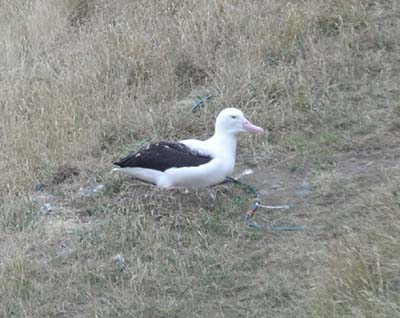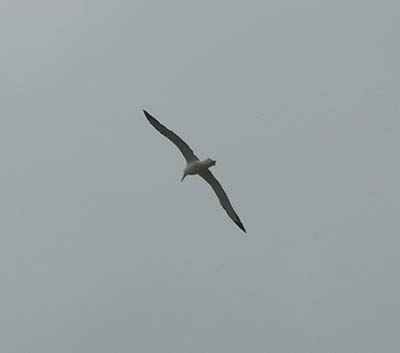KATIE'S KOMMENTS
Katie's Komments: The Royal Albatross

This week we went to a really cool Royal Albatross Reserve in Taiaroa. We learned a lot about these fascinating birds and even got to see them nesting and flying with our own eyes. The first time I saw one of these birds flying I was completely amazed. They looked more like those huge flying pterodactyl dinosaurs, than any bird I'd ever seen. Let's put it this way, they were huge! These monstrous birds have an average wing span of about 9 feet. The structure of their wings is also very unique. They are made up of three segments; however the albatross don't usually flap them. Instead they glide in the wind, adjusting their wings as they go. They fly a maximum speed of 100 kilometers per hour - that's about 65 miles per hour. While in the observatory we were lucky enough to see one fly right over the roof, which really gave us a sense for their size and beauty.
Royal Albatrosses spend about 80% of their life at sea, which means they need some special qualities to survive when drinking the salty water. We learned that the glands in the top of their forehead extract the extra salt from the albatross's body and drain it through a part of their beak. Their diet consists of squid, crayfish, and other sea creatures, usually the dying ones which float to the top of the water. Most nest on the Chatham Islands of New Zealand because they have lots of wind and no people living on them. The Taiaroa Reserve is the only one in the world which provides opportunities to see these albatross.
 Royal
Albatrosses are thought to fly great distances, circling around Antarctica
and the Southern Hemisphere, however no one knows for sure. There have been
some efforts to try and track these birds, but unfortunately none have come
into play yet. They do put bands on the birds' wings at certain ages to keep
track of each albatross' individual history, health status etc. Royal Albatross',
as I said spend, most of their life at sea, however they do come back to land
every other year to breed. They mate for life and have one chick each year
that they breed. When the chick hatches it is tiny, and the parents take turns
sitting on the nest and finding food. The chicks are often eaten by small
animals such as stoats and ferrets. There have been many efforts to kill as
many of these animals as possible, using traps, etc. At 3 months, however,
these birds are no longer vulnerable. The chicks get very hungry and can eat
4 lbs. of food in 14 minutes. Wow!!! At this time they are twice the size
and weight of their own parents - 14-20 lbs. The parents then start putting
the chick on a diet and the chicks thankfully begin to loose a little weight.
They then start learning how to fly on their own. When they have finally perfected
catching the wind, they go out on their own and don't return for 3-4 years,
before they decide it is time for them to find a mate. They are very independent
and solitary birds. The albatross will return to its colony and try to find
a mate which it keeps for life. The cycle begins once again.
Royal
Albatrosses are thought to fly great distances, circling around Antarctica
and the Southern Hemisphere, however no one knows for sure. There have been
some efforts to try and track these birds, but unfortunately none have come
into play yet. They do put bands on the birds' wings at certain ages to keep
track of each albatross' individual history, health status etc. Royal Albatross',
as I said spend, most of their life at sea, however they do come back to land
every other year to breed. They mate for life and have one chick each year
that they breed. When the chick hatches it is tiny, and the parents take turns
sitting on the nest and finding food. The chicks are often eaten by small
animals such as stoats and ferrets. There have been many efforts to kill as
many of these animals as possible, using traps, etc. At 3 months, however,
these birds are no longer vulnerable. The chicks get very hungry and can eat
4 lbs. of food in 14 minutes. Wow!!! At this time they are twice the size
and weight of their own parents - 14-20 lbs. The parents then start putting
the chick on a diet and the chicks thankfully begin to loose a little weight.
They then start learning how to fly on their own. When they have finally perfected
catching the wind, they go out on their own and don't return for 3-4 years,
before they decide it is time for them to find a mate. They are very independent
and solitary birds. The albatross will return to its colony and try to find
a mate which it keeps for life. The cycle begins once again.
As you can see, we learned a lot about Royal Albatross, and were completely fascinated by the brilliance of this bird and the people of New Zealand, who work so hard to protect these amazing birds and other native animals for the next generation to see.
